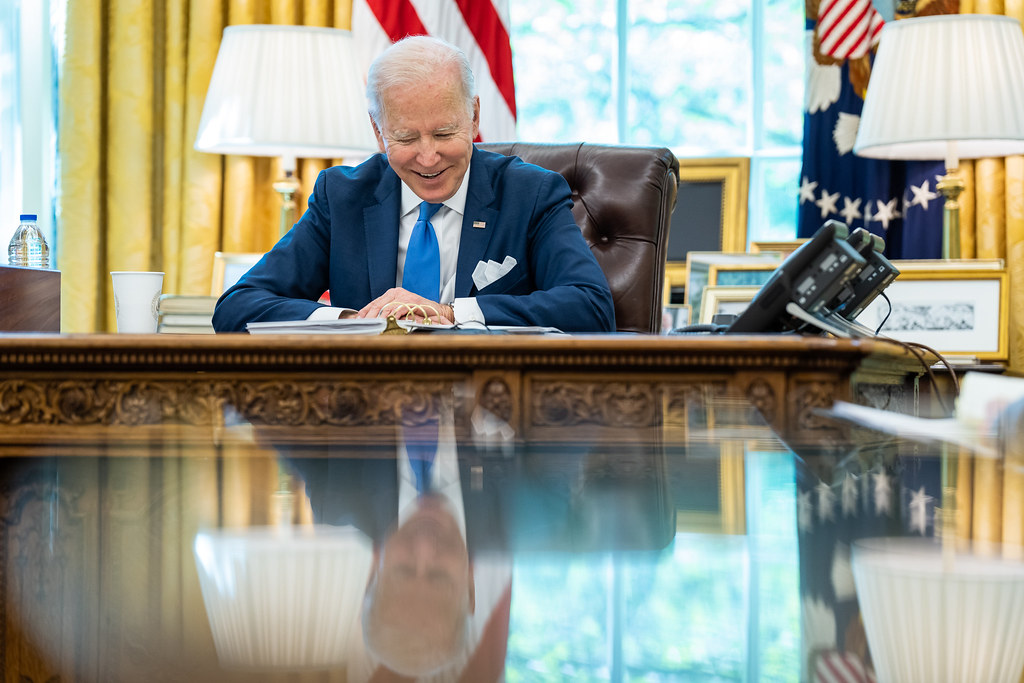Biden Wants Federal Workers Back at the Office
A pandemic-inspired perk seems to be going away.

Axios (“Scoop: Biden pushes to end remote work era for feds“):
President Biden is calling for his Cabinet to “aggressively execute” plans for federal employees to work more in their offices this fall after years of working remotely, according to an email sent Friday to every Cabinet member and obtained by Axios.
Why it matters: It’s Biden’s most overt push yet to get federal employees to return to their offices — a dynamic many businesses also have struggled with as Americans continue to embrace remote work despite the pandemic waning.
Driving the news: In an email to the Cabinet on Friday, White House Chief of Staff Jeff Zients wrote: “We are returning to in-person work because it is critical to the well-being of our teams and will enable us to deliver better results for the American people.”
- He added: “As we look towards the fall, and with the end of the COVID-19 public health emergency, your agencies will be implementing increases in the amount of in-person work for your team. This is a priority of the President — and I am looking to each of you to aggressively execute this shift in September and October.”
- Zients wrote that the changes will not eliminate working remotely but rather combine that flexibility “while ensuring we have the in-person time we need to build a strong culture, trust, and interpersonal connections.”
- A Government Accountability Office report published last month found that “17 of the 24 federal agencies used on average an estimated 25 percent or less of the capacity of their headquarters buildings.”
Much of the report centers on the White House itself, which is not particularly interesting to me. It is, after all, a unique workplace and, honestly, I’m surprised that it didn’t return to full-time in person long before now.
My wife and I both work for the Federal government, so I’ve got more than a passing interest in this.
She was already teleworking with some regularity before the pandemic and went full-time remote during it and for a long time thereafter. She switched to a different position about a year ago and now has to go in two days a week for, frankly, no good reason. It’s done on a rotating basis, so there’s no improvement in collegiality or collaboration as the team is essentially never together at one time. Regardless, not only is saving roughly two hours a day in commuting time to the Pentagon the other three days welcome, it’s definitely a boon in terms of managing school activities and the like.
The staff college where I work reluctantly went remote in mid-March 2020 and finished out the academic year (through early June) that way. Because we’re a resident school with a huge non-resident alternative, there was extreme pressure to get back rolling. We delayed the start of the 2021-22 academic year by about a month but we’ve been more-or-less fully in-person since August 2021. (We were aggressive in having faculty and staff with COVID symptoms or even close contacts go remote—often at the conference group level—until pretty recently.)
With regard to the larger Federal workforce, there have certainly been strong signals that this move was coming. But it seems to be driven by external concerns rather than the needs of the workplace.
Zoom out: Biden has been talking about bringing federal workers back to the office since the spring of 2022 with limited success.
- In his State of the Union in March 2022, Biden pledged that “the vast majority of federal workers will once again work in person.”
- […]
- In April, the Office of Management and Budget ended maximum telework and sent out further instructions for agencies to develop plans to increase in-person work. Zients’ letter aims to speed up that move.
[…]
The big picture: The political pressure on the White House to curb remote work has included demands from Republicans in Congress, who have blamed telework for delays and backlogs in agencies’ work.
- Democrats, advocacy groups and some unions have largely blamed lack of funding for such issues and cite telework as a key tool in recruiting staff.
- Some senior administration officials never fully moved to D.C., including former Labor Secretary Marty Walsh.
What they’re saying: In her third inaugural address in January, D.C. mayor Muriel Bowser raised alarm bells about the city’s rising number of vacant office spaces.
- “We need decisive action by the White House to either get most federal workers back to the office most of the time or to realign their vast property holdings for use by the local government, by nonprofits, by businesses and by any user willing to revitalize it,” she said.
- Telework’s economic impact has been significant for many cities, including Washington, D.C., where local businesses and politicians have been pressuring the White House to demand more in-person work.
- This week, former New York City Mayor Mike Bloomberg penned an op-ed in The Washington Post on the topic:
- “The federal government should lead by example, and the president should keep his promise,” Bloomberg wrote. “Taxpayers deserve immediate action and hard deadlines — and the better service and stronger capital city that will result.”
It seems obvious to me that cabinet officers and other senior officials should live in DC and go into the office. It’s hard to lead remotely. For others, it seems to me that it should be decided on an office-by-office, if not job-by-job, basis. If the job requires routine collaboration, being in person is likely of considerable benefit. If it requires a lot of quiet reflection to produce written products, do data entry, or the like then remote is likely more efficient.
The move seems to be inspired by ancillary concerns, especially local businesses who benefit from having office workers pay for lunch, dry cleaning, and the like. Or retail rents. I understand why mayors and others who benefit from these businesses are pushing for a return to work. But it makes little sense for the President to be doing so.
Democratic Presidents going back to Jimmy Carter have been pushing for telework, both to conserve energy and to reduce pollution and traffic congestion. The Federal government employs more than 2 million civilians. The most recent figures I have, from 2022, showed 14% were working fully remotely while 42% teleworked between one and three days a week. That’s pretty significant in and of itself; to the extent this is supposed to set an example for other industries, even moreso.
Politically, this seems against the President’s interests. There’s no obvious upside for him in that I can’t imagine the voter who will be swayed in his direction by this move—assuming they even have any idea he’s made it. Yet, it’ll be unpopular with a fairly significant piece of the Democratic base—the government workers directly affected by it. And it’ll make it harder for agencies, who compete with a private sector that’s still offering maximum telework for talent, to recruit.





Given the federal government already has a big recruiting/retention problem, this seems a boneheaded policy
I’m also not sure how this helps the city’s vacancy problem since federal workers aren’t going to be using leased office space even if they are in the office.
There are a number of decent studies out lately showing work from home having reduced productivity. One study showed that those who most wanted to WFH were those most likely to have reduced productivity. Early on it was pretty clear that new workers dont do so well with WFH. I think that you either need to reduce WFH or you need to have management be much more aggressive about monitoring the work done by those working at home. It’s a really nice perk but I think those receiving it, some large minority of them at least, are ruining it.
Steve
You would do well to read some statistical coverage on the evolution – particularly sub-national geographically, not journalists and tech people selling their views as your Washington area impression is clearly rather misplaced. Private sector is moving heavily ex your region away.
Of course I having made a Spring trip to DC to see USGov people re business found their general absence and ongoing “oh I have connexion issues” to be quite tiresome as a starkly less efficient (for the Consumer of Service PoV). For the US ratepayer, one should be quite cross…
@steve: Yes. Accumlating statistics, metrics (one should of course differentiate between full or dominately remote and flex work with significant amount of office face time [e.g. 3 days out of 5])
And in own company experience the skill transfer and issues for young employees I find to be painfully impactful to the negative for them. Ad hoc face time is very useful to them, even if older workers see it as “oh bother talk to the intern.” Or the junior.
This. My company wants me in the office 3 days a week; they get about 1.5 on average. Since I can’t count on any particular person being in on any given day, there is no benefit to being there in person (and major disadvantages related to the IT infrastructure and rules). If they would just go to a 3 day in-person week, with all of us in on the same days, everyone would be better off and doing better work.
@Lounsbury:
Also this.
When lockdown hit, we all powered through and got the work done. But recruiting, onboarding, and mentoring have flat out sucked ever since. The next generation of project leaders is going to be stunted and inept, and I don’t think management realizes that yet.
Taylorism has taught us that when changes are made to workflow, productivity increases, but as the changes become the norm/routine, productivity falls back to its previous level. It shouldn’t be surprise that the move to remote work caused a bump in productivity and it shouldn’t be a surprise that productivity has dropped over time.
One of the few good ideas that I thought the Trump admin had, though it never was implemented, was moving bureaucratic agencies out of Washington to a region of the country that falls under the agency purview. If the bureaucrats are working from home, why not move the office to say Omaha or Waco? Be care full what you wish for, that next promotion may require a move.
@Sleeping Dog:
There’s no such thing as a “promotion” in the federal civil service. This is one of the big ongoing problems for retaining a skilled federal workforce. In the GS system, you get hired into a position at a specific GS grade that you are (ostensibly) already qualified for, and you then get seniority bumps (“step increases”) over time. If you want to get a higher GS rating, you have to move to a new position via open competition. There are no “career tracks” or “growth pathways” — you have to invent your own. There are no raises other than step increases, though (tiny) performance bonuses are possible. It’s effectively the opposite of the military “up or out” system.
…all of which is to say that it has always been true that “that next promotion might require a move”.
It’s when the crew of the USS Gerald R. Ford started demanding to work from home. . .
I’ve been working from home since about 1990. It takes a certain type of person and a certain type of job. And I use crutches – my immediate environment, cigars, coffee, music, sometimes Adderall. Sometimes I basically simulate an office environment by working in a coffee shop or a cigar bar, it forces me to either work or look like an idiot staring at a laptop.
It isn’t easy for a lot of people, not as easy as they think it will be. Most people are social animals, they need to be with people.
WFH is part of the reason I bailed on LA. I was in LA to facilitate occasional Hollywood moments. Then came Covid and Zoom and I realized I was Zooming with people in the UK and Australia and even people just five miles away. I don’t need to be paying Los Angeles housing prices and fighting the eternal traffic and paying 13% in state taxes just to Zoom.
@DrDaveT: Re Stunted project managers, I am effectively CEO and it is one of my most painful concerns and amongst my management circles widely held. However during the 21-22 period in face of combination of inflation and recruitment struggles we have tolerated habits as too many different balls to handle at once plus this- recovery, logistics, weird market distortions.
@Lounsbury:
Why, as an employee, would I want to more effectively transfer the skills that make me too costly to lay off at the first chance to another employee who is probably also much cheaper than me?
@Stormy Dragon:
Perhaps, yes. I read today’s Washington Post editorial linking the persistent strength in the job market and increased workforce participation to the both goverment-related hiring and flexibility of WFH, especially with young workers and parents. It was pretty convincing, especially as WaPo has been Bidenomics-skeptical. Maybe the White House consider the data before making any rash decisions.
My govie wife is not pleased to be asked to go to the office yet another day each week. She already has 1 in-person day that’s a throwaway because not everybody is there, so it’s just her in an almost-empty building taking Teams meetings like she would at home. This costs her money and time, and it benefits nobody.
But hey, I ignore our company’s 1-day-a-week policy. There are a half dozen reasons for me not to go in, and only one reason (“it’s policy”) to do it. My in-person interactions on that 1 day are typically between me and the three people I most frequently text anyway, so it’s better for the company if I instead spend $5 at the local coffee shop and start working at 7:30am.
There are obviously jobs where in-person attendance is necessary or just preferred, but most academic/white collar jobs are not those. And the government sure is full of academic/white collar jobs.